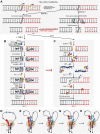DNA Damage Response and Repair in Adaptive Immunity
- PMID: 35663402
- PMCID: PMC9157429
- DOI: 10.3389/fcell.2022.884873
DNA Damage Response and Repair in Adaptive Immunity
Abstract
The diversification of B-cell receptor (BCR), as well as its secreted product, antibody, is a hallmark of adaptive immunity, which has more specific roles in fighting against pathogens. The antibody diversification is from recombination-activating gene (RAG)-initiated V(D)J recombination, activation-induced cytidine deaminase (AID)-initiated class switch recombination (CSR), and V(D)J exon somatic hypermutation (SHM). The proper repair of RAG- and AID-initiated DNA lesions and double-strand breaks (DSBs) is required for promoting antibody diversification, suppressing genomic instability, and oncogenic translocations. DNA damage response (DDR) factors and DSB end-joining factors are recruited to the RAG- and AID-initiated DNA lesions and DSBs to coordinately resolve them for generating productive recombination products during antibody diversification. Recently, cohesin-mediated loop extrusion is proposed to be the underlying mechanism of V(D)J recombination and CSR, which plays essential roles in promoting the orientation-biased deletional end-joining . Here, we will discuss the mechanism of DNA damage repair in antibody diversification.
Keywords: AID-initiated CSR and SHM; DNA damage repair; RAG-initiated V(D)J recombination; antibody diversification; cohesin-mediated loop extrusion.
Copyright © 2022 Luo, Qiao and Zhang.
Conflict of interest statement
The authors declare that the research was conducted in the absence of any commercial or financial relationships that could be construed as a potential conflict of interest.
Figures




Similar articles
-
Orientation-specific joining of AID-initiated DNA breaks promotes antibody class switching.Nature. 2015 Sep 3;525(7567):134-139. doi: 10.1038/nature14970. Epub 2015 Aug 26. Nature. 2015. PMID: 26308889 Free PMC article.
-
Mechanism and control of V(D)J recombination versus class switch recombination: similarities and differences.Adv Immunol. 2005;86:43-112. doi: 10.1016/S0065-2776(04)86002-4. Adv Immunol. 2005. PMID: 15705419 Review.
-
Cis- and trans-factors affecting AID targeting and mutagenic outcomes in antibody diversification.Adv Immunol. 2019;141:51-103. doi: 10.1016/bs.ai.2019.01.002. Epub 2019 Feb 11. Adv Immunol. 2019. PMID: 30904133 Review.
-
Fundamental roles of chromatin loop extrusion in antibody class switching.Nature. 2019 Nov;575(7782):385-389. doi: 10.1038/s41586-019-1723-0. Epub 2019 Oct 30. Nature. 2019. PMID: 31666703 Free PMC article.
-
The Complex Interplay between DNA Injury and Repair in Enzymatically Induced Mutagenesis and DNA Damage in B Lymphocytes.Int J Mol Sci. 2017 Aug 30;18(9):1876. doi: 10.3390/ijms18091876. Int J Mol Sci. 2017. PMID: 28867784 Free PMC article. Review.
Cited by
-
Progression of monoclonal gammopathy of undetermined significance to multiple myeloma is associated with enhanced translational quality control and overall loss of surface antigens.J Transl Med. 2024 Jun 7;22(1):548. doi: 10.1186/s12967-024-05345-x. J Transl Med. 2024. PMID: 38849800 Free PMC article.
-
The multifaceted functions of DNA-PKcs: implications for the therapy of human diseases.MedComm (2020). 2024 Jun 19;5(7):e613. doi: 10.1002/mco2.613. eCollection 2024 Jul. MedComm (2020). 2024. PMID: 38898995 Free PMC article. Review.
-
Nontraditional Roles of DNA Polymerase Eta Support Genome Duplication and Stability.Genes (Basel). 2023 Jan 9;14(1):175. doi: 10.3390/genes14010175. Genes (Basel). 2023. PMID: 36672916 Free PMC article. Review.
References
Publication types
LinkOut - more resources
Full Text Sources

